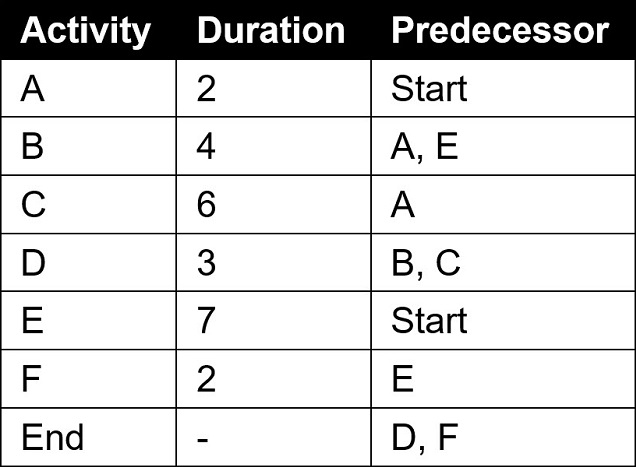The following table is an activity list that includes the duration and predecessor for a series of project activities.
What is the duration of the critical path?
A. 11
B. 14
C. 9
D. 13
HINT: Do you need to draw a project schedule network diagram, or can you simply list all the possible the sequences of paths with the given activities? Which path constitutes the critical path?
All our questions are updated to the latest
A Guide to the Project Management Body of Knowledge (PMBOK® Guide) standard. Stop by at
free.pm-exam-simulator.com/
and try the PM Exam Simulator free for 7 days. We are a trusted and experienced education provider.
Answer and Explanation:
The correct answer is B.
Using the critical path method may require drawing a project schedule network diagram, or listing all the possible the sequences of paths with the given activities, then adding up the durations, and knowing which path constitutes the critical path.
Given the activity list shown, you can see that:
Start serves as predecessor for both A and E, creating a divergence into two paths.
Activity A serves as predecessor for both B and C, creating another divergence.
Activity E serves as a predecessor for both B and F, creating another divergence.
The project schedule network diagram is as follows.
The resulting list of paths with their aggregated durations is below. The critical path is Start-E-B-D-End, and the duration of the critical path with the data given is 14.
Details for each option:
A. Incorrect. You might have chosen this answer if you picked the first path to be drawn according to the values in the table. However, Start-A-C-D-End has a duration of only 11, not the longest path in this sequence.
B. Correct. Start-E-B-D-End has a duration of 14, which is the longest path in this sequence, making it the critical path.
C. Incorrect. You might have chosen this answer if you used Start-E-F-End, which is the shortest path in this sequence. However, that does not define the critical path.
D. Incorrect. You might have chosen this answer if you used Start-E-B-F-End, but that is an invalid path because B does not precede F; it only precedes D.
Reference:
A Guide to the Project Management Body of Knowledge (PMBOK® Guide) – Seventh Edition, Project Management Institute Inc., 2021,
2.7.2.3 Baseline Performance
Process Groups: A Practice Guide, Project Management Institute Inc., 2023,
5.10 Develop Schedule
10 Tools and Techniques
Practice Standard for Scheduling - Third Edition, Project Management Institute, 2019,
2.2.1 CRITICAL PATH APPROACH
3.4.1.1 CRITICAL PATH



